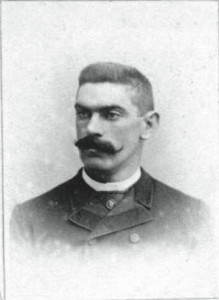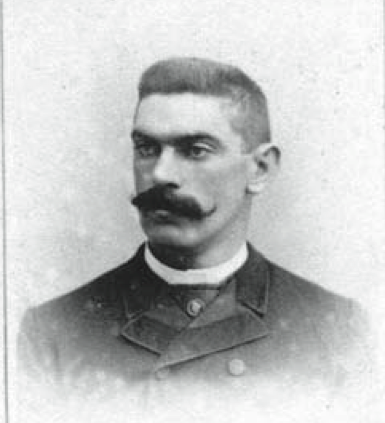October 5, 1884: Maroons’ Sweeney, Boyle combine to toss and lose rain-shortened Union Association no-hitter
 The first and only season of the Union Association was coming to a merciful conclusion. Founded in September 1883 by St. Louis millionaire Henry Lucas, the league was beset by franchise and financial instability, as well as inequitable talent distribution. Despite conflicts of interest, Lucas purchased the best available players for his team, the St. Louis Maroons, who ran roughshod over the competition in the eight-team circuit. Four weeks into the season, the Altoona Mountain Citys folded.1 Three more clubs followed. Each disbanded team was subsequently replaced by another team, one that either was quickly formed or invited from another league.
The first and only season of the Union Association was coming to a merciful conclusion. Founded in September 1883 by St. Louis millionaire Henry Lucas, the league was beset by franchise and financial instability, as well as inequitable talent distribution. Despite conflicts of interest, Lucas purchased the best available players for his team, the St. Louis Maroons, who ran roughshod over the competition in the eight-team circuit. Four weeks into the season, the Altoona Mountain Citys folded.1 Three more clubs followed. Each disbanded team was subsequently replaced by another team, one that either was quickly formed or invited from another league.
The Maroons got off to a 24-1 start. By June 21 they had opened up a double-digit lead over the second-place Baltimore Monumentals and never looked back. Managed by Ted Sullivan for the first 31 games and then second baseman Fred Dunlap, the Maroons were 88-15, easily the best record among the three major leagues (Union Association, American Association, and National League) when they took on the St. Paul White Caps on Sunday, October 5, as part of a season-ending 14-game homestand.
The White Caps were searching for their first victory of the season; then again, they had joined the league just a week earlier and played their inaugural game on September 27. They had been recruited from the Northwest League (where they were known as the Apostles and had produced a miserable 29-54 record) to replace the Pittsburgh Stogies. The Stogies had begun the season as the Chicago Browns, played their last game in the Windy City on August 21, and lasted less than a month in the Smoky City before they disbanded on September 18. The newly renamed White Caps had played four games in the Union Association.
The starting pitcher for the Maroons was Charlie Sweeney, whom Hall of Fame hurler Tim Keefe once described as the “greatest twirler that ever lived.”2 For one season – 1884 – Sweeney might have been the greatest. He was also a prima donna and “narcissistic to a fault,” wrote Chris Rainey in Sweeney’s SABR BioProject entry.3
A robust 5-foot-10, 190-pound right-hander from San Francisco, Sweeney debuted as a 20-year-old with the National League’s Providence Grays in 1883 and went 7-7 as the club’s secondary pitcher to Old Hoss Radbourn, who started 68 of the Grays’ 98 games and won 48. He began 1884 with Providence but, as Rainey explained, rumors surfaced in June 1884 that the Maroons were attempting to pry Radbourne loose from his contract. During the middle of a pennant race, the Grays eventually suspended each pitcher in separate incidents of insubordination. While Radbourn rejoined the club, Sweeney (17-8) jumped his contract and signed with the Maroons in late July to replace their top pitcher, Billy Taylor (25-4), who had jumped to the American Association Philadelphia Athletics.
On an unseasonably hot Sunday afternoon with temperatures approaching 90 degrees, Union Grounds was packed with a crowd estimated by the St. Louis Globe-Democrat to be 5,000 strong.4 The wooden ballpark, which had been inaugurated in the Maroons’ home opener on April 20, was located on the city’s north side, near the current intersection of Jefferson and Cass Avenues on what became the Pruitt-Igoe housing project in the 1950s.5
Sweeney had no problem adjusting to the less competitive Union Association despite a major rules difference. In all three leagues, pitchers hurled from a 6-feet-deep by 4-feet-wide pitcher’s box, the front of which was located 50 feet from home plate.6 In 1884 the NL lifted all restrictions on pitchers’ delivery, thus permitting an overhand motion, but the Union Association and the AA did not follow suit. Strikeouts in the NL jumped from an average of 7.4 per game to 9.6. On June 7 Sweeney gained national notoriety by fanning 19 in a game against the Boston Beaneaters, a mark equaled by the Chicago Browns’ Hugh Daily a week later. No major-league pitcher exceeded that mark in a nine-inning game until Roger Clemens of the Boston Red Sox fanned 20 in 1986.7
In a sport filled with “could haves,” Sweeney might have set a new strikeout record facing the White Caps’ ragtag lineup of inexperienced players. He punched out the first six batters he faced and then decided he had enough. In the top of the third, he traded positions with Henry Boyle. “Not caring to a make a record against the St. Pauls,” reported the Globe-Democrat, “and just to give the fielders a chance, Sweeney went to left field.”8
Picking up where Sweeney left off, Boyle set down the side in order in the third. Handsome Henry was a 24-year-old rookie from Philadelphia who was the Maroons’ regular left fielder and took the mound about once a week. The future for the 6-foot-1, 165-pound, weak-hitting right-hander proved to be on the mound. He finished the ’84 season with a 15-3 slate and 89-111 in parts of six big-league seasons.
Boyle began the fourth by retiring Scrappy Carroll on a fly out. Bill Barnes, playing in just his fifth professional game, hit a chopper to shortstop Milt Whitehead, who fumbled it. After Barnes stole second, Boyle fielded Moxie Hengel’s tapper back to the mound and threw to first for the second out. Joe Quinn, in his first season of a productive 17-year big-league career, rifled the ball to third in an attempt to nab Barnes. The throw was low and got by Jack Gleason, reported the Globe-Democrat, for the second error of the inning, and Barnes scampered home for what proved to be the only run of the game.9
While Sweeney and Boyle held the White Caps hitless through five innings and did not issue a walk, White Caps hurler Jim Brown pitched almost as well, and his defense played error-free ball. The 23-year-old rookie from Pennsylvania experienced a season of instability mirroring that of the Union Association. He started with Altoona, winning one of 10 decisions, subsequently pitched a game for the NL New York Giants, and later signed with the White Caps. In this game, Brown yielded just one hit, to Sweeney (who batted .316 with the Maroons), and issued two free passes.
By the beginning of the fifth inning “threatening clouds hovered about the park,” reported the Globe-Democrat.10 An inning later, “rain came down in torrents,” continued the paper, sending players and spectators for cover. Umpire Harry McCaffrey, who had played for the American Association St. Louis Brown Stockings in 1882 and 1883, declared the game official after 30 minutes despite the protestations of some fans to “Play Her Out.”11 Though the rain had ceased, McCaffrey decided that the field was too wet.
McCaffrey declared the White Caps 1-0 victors over the Maroons in a game that lasted 50 minutes. It was the first of two victories for the team that played all eight of its games on the road. The White Caps “proved themselves a fine lot of players,” lauded the Globe-Democrat.12
For more than a century Sweeney and Boyle had the distinction of being the first big-league teammates to combine for a no-hitter, albeit a rain-shortened five-inning no-no. The Red Sox’ Babe Ruth, who was ejected in an argument with the umpire after walking the first batter of the game, and Ernie Shore were the first teammates to toss a combined nine-inning no-hitter, on June 23, 1917. The Baltimore Orioles’ Tom Phoebus (8⅔ innings) and Stu Miller (⅓ inning) were the next pair, holding the Red Sox hitless, yet losing, 2-1, on April 30, 1967.
Sweeney’s and Boyle’s names were removed from Major League Baseball’s official list of no-hitters in September 1991, when MLB’s Committee for Statistical Accuracy changed the definition of a no-hitter to include only those games that last at least nine innings and end with no hits. An estimated 36 shortened no-hitters were removed.
Sweeney and Boyle’s originally classified no-hitter occurred in what should be known as the year of the no-hitter. One day after Sam Kimber of the AA Brooklyn Atlantics held the Toledo Blue Stockings hitless in a scoreless 10-inning game on October 4, Sweeney and Boyle combined for the 12th and final no-hitter, and fourth truncated one, in the three major leagues in 1884.
Sweeney finished his abbreviated tenure with the Maroons with a 24-7 record to push his season mark to 41-15 with 337 strikeouts. The Union Association disbanded after the season, and the St. Louis team joined the NL. Sweeney eventually joined St. Louis, too, but suffered arm problems and won only 17 more games in parts of the next three seasons. He went 64-52 in his career.
Acknowledgments
This article was fact-checked by Stew Thornley and copy-edited by Len Levin.
Photo credit: National Baseball Hall of Fame Library.
Sources
In addition to the sources cited in the Notes, the author accessed Retrosheet.org, Baseball-Reference.com, and SABR.org.
Notes
1 The author recognizes the confusion over and discrepancies with nicknames of nineteenth-century baseball teams. For more on that topic, see Ed Coen, “Setting the Record Straight with Major League Team Nicknames,” Baseball Research Journal, Vol. 48, No. 2 (2019): 67-75, https://sabr.org/journal/article/setting-the-record-straight-on-major-league-team-nicknames/.
2 San Francisco Chronicle, December 19, 1887: 5.
3 Chris Rainey, “Charlie Sweeney,” SABR BioProject, accessed October 9, 2023, https://sabr.org/bioproj/person/charlie-sweeney/.
4 “Sporting. St. Pauls 1; St. Louis Unions 0,” St. Louis Globe-Democrat, October 6, 1884: 5.
5 Philip J. Lowry, Green Cathedrals. The Ultimate Celebration of All Major League and Negro League Ballparks, 5th edition (Phoenix: Society for American Baseball Research, 2019), 259.
6 Eric Miklich, “The Pitcher’s Area,” 19C Baseball, accessed October 9, 2023, http://www.19cbaseball.com/field-8.html.
7 Tom Cheney of the Washington Senators struck out 21 in a 16-inning game on September 12, 1962.
8 “Sporting. St. Pauls 1; St. Louis Unions 0.”
9 “Sporting. St. Pauls 1; St. Louis Unions 0.”
10 “Sporting. St. Pauls 1; St. Louis Unions 0.”
11 “Sporting. St. Pauls 1; St. Louis Unions 0.”
12 “Sporting. St. Pauls 1; St. Louis Unions 0.”
Additional Stats
St. Paul Whitecaps 1
St. Louis Maroons 0
5 innings
Union Grounds
St. Louis, MO
Corrections? Additions?
If you can help us improve this game story, contact us.


